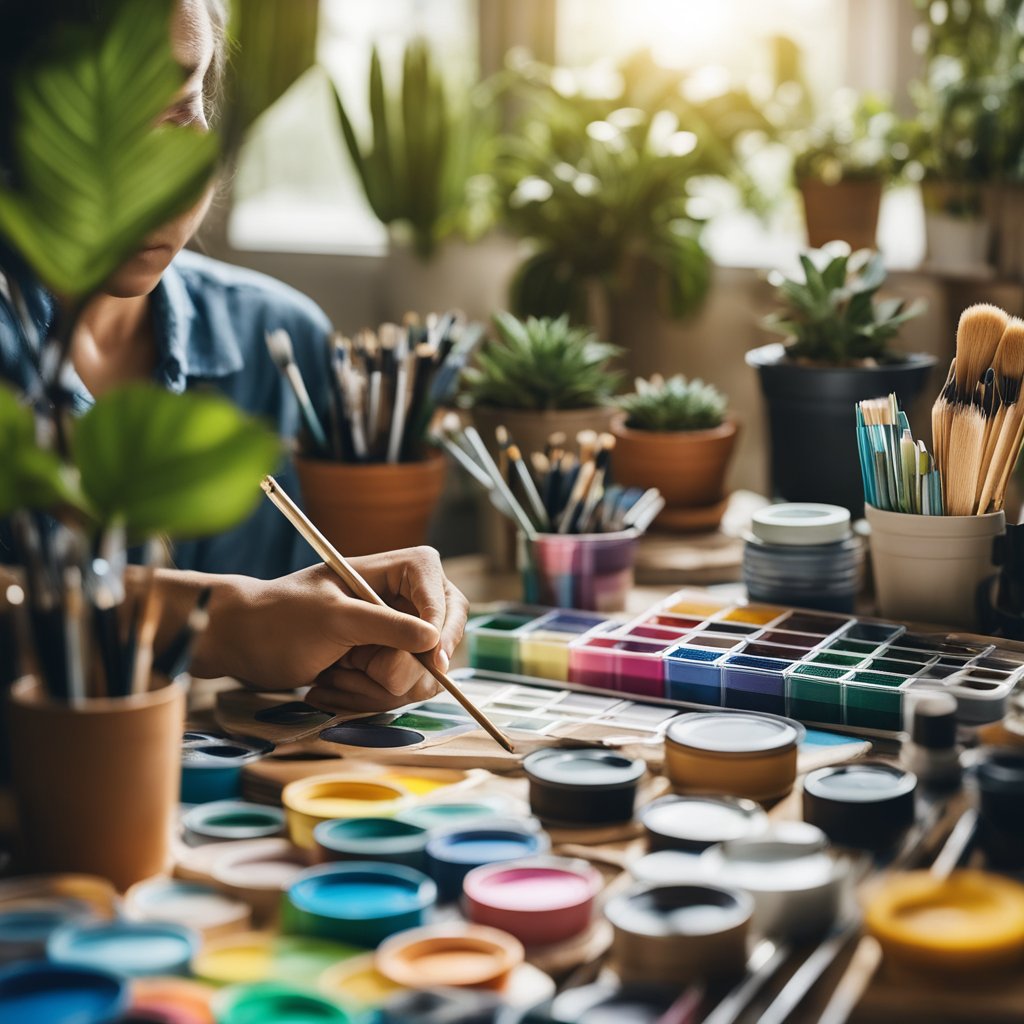Tips for Boosting Creativity in Your Everyday Life: Practical Strategies for Inspiration and Innovation
By Alex Reynolds |

Tips for Boosting Creativity in Your Everyday Life: Practical Strategies for Inspiration and Innovation
Creativity is essential in many aspects of life, from problem-solving to personal expression. Many people, however, struggle to tap into their creative potential on a daily basis. Simple changes in routine and mindset can significantly enhance one’s creative thinking and output.
Incorporating creative practices into everyday activities can lead to fresh ideas and perspectives. Whether through journaling, engaging in artistic hobbies, or exploring new experiences, there are numerous strategies that can help boost creativity.
Additionally, understanding how to create an environment conducive to innovation is crucial. By establishing routines that promote relaxation and inspiration, individuals can foster their creativity more naturally. Engaging with diverse thoughts and approaches can unlock new levels of imagination and creativity.
Understanding Creativity
Creativity is a complex concept that varies from person to person. It’s not just about art or music; it plays a role in problem-solving and innovation. Exploring its definition, the science behind it, and common myths can help clarify its importance in everyday life.
Defining Creativity
Creativity can be described as the ability to produce new ideas or concepts. It involves thinking differently and finding unique solutions. This can include artistic expression, such as painting or writing, as well as practical applications, like inventing new tools or strategies.
Creativity often requires both imagination and critical thinking. Imagination helps generate ideas, while critical thinking assesses their validity. Ultimately, creativity is valuable in many areas, from personal projects to professional tasks.
The Science Behind Creativity
Research shows that creativity involves several brain functions and areas. The left hemisphere is linked to analytical thinking, while the right hemisphere is associated with creative thought. Engaging both sides can enhance creative processes.
Neurotransmitters, such as dopamine, also play a role in creativity. Higher dopamine levels can lead to increased motivation and idea generation. Environments that encourage curiosity and exploration contribute to enhanced creativity in individuals.
Myths About Creativity
Many people believe that creativity is solely an inborn talent. In reality, creativity can be developed and nurtured. While some individuals may have natural abilities, practice and exposure can improve creative skills.
Another common myth is that creativity only thrives in solitude. Collaboration and interaction can often spark new ideas. Group projects or discussions can lead to unexpected solutions and are essential for collective creativity.
Cultivating a Creative Environment
Creating a creative environment is essential for boosting imagination and innovation. This includes how one organizes their physical space and the importance of comfort and relaxation. These factors can significantly influence creative thinking and productivity.
Organizing Your Physical Space
A well-organized physical space enhances focus and sparks creativity. Clutter can distract and overwhelm. Therefore, keeping a tidy area is vital.
Tips for Organizing:
- Declutter Regularly: Remove items that are not needed to create a clean workspace.
- Use Zones: Designate areas for different activities, like brainstorming or relaxing.
- Incorporate Inspiration: Add art, quotes, or tools that motivate and stimulate ideas.
Having access to materials is also important. For instance, a well-stocked supply of art supplies or writing tools can encourage spontaneous creativity.
The Role of Comfort and Relaxation
Comfort and relaxation contribute significantly to creativity. A comfortable environment allows for free thinking and reduces stress.
Key Factors for Comfort:
- Ergonomic Furniture: Chairs and desks that support good posture help maintain focus.
- Ambient Lighting: Soft lighting can create a calming atmosphere. It helps avoid eye strain too.
- Personal Touches: Adding favorite items, like plants or artwork, makes the space feel more inviting.
Integrating periods of relaxation into the day can also help. Short breaks allow the mind to recharge, often leading to new ideas when returning to tasks.
Incorporating Creativity Into Daily Routines
Establishing creative habits within daily routines can significantly enhance one’s ability to think outside the box. Simple changes, when made consistently, can invite more creativity into everyday life.
Creative Morning Rituals
Mornings set the tone for the day. Creating a morning ritual can ignite inspiration and boost creativity. One effective approach is to begin the day with mindfulness exercises, such as meditation or journaling. This practice helps clear the mind and encourages new ideas to flow.
Incorporating creative activities like sketching, dancing, or writing poetry during breakfast can also stimulate the brain. Even a brief 10-minute exercise like doodling can unlock fresh perspectives.
Another idea is to mix up the environment by enjoying breakfast in a different location, like outdoors or at a café. New surroundings can lead to new thoughts and creativity.
Transforming Mundane Tasks
Daily chores often feel repetitive, but they can be transformed into creative opportunities. One way to do this is by gamifying tasks. For example, setting a timer to complete chores can make them more engaging. It turns cleaning into a fun challenge.
Another approach involves adding an artistic twist to routine tasks. For instance, while doing dishes, one can listen to music and imagine the sounds as a personal soundtrack. This adds a creative layer to a mundane task.
Additionally, combining work with small, creative projects can break the monotony. For example, she might integrate creative thinking into her work tasks by brainstorming new ideas while organizing files. These small shifts can make daily routines more enriching and creative.
Engaging in Creative Activities
Engaging in creative activities is essential for fostering self-expression and building new skills. Various forms of creative expression can enhance one’s imagination and offer a sense of accomplishment. Art, writing, and music all provide unique avenues for creativity.
Art and Craft
Art and craft activities, such as drawing, painting, and sculpting, allow individuals to express themselves visually. These practices can range from simple doodling to complex projects like pottery or collage.
Benefits of engaging in art include improved mood, stress relief, and increased focus. Creating art also enhances fine motor skills. Joining community art classes or exploring online tutorials can provide further inspiration and guidance.
Simple materials are often enough to get started. Items like colored pencils, paper, and clay can spark creativity without requiring a large investment.
Writing and Journaling
Writing and journaling are effective outlets for creativity. Whether it is through poetry, short stories, or daily entries, the written word allows individuals to articulate thoughts and feelings.
Journaling can promote self-reflection and mindfulness. It helps clarify ideas and enhances vocabulary and writing skills. Setting aside time each day to write can lead to deeper insights and greater creativity.
People can explore prompts or themes to spark their imagination. Tools like gratitude journals and creative writing exercises can help structure this practice.
Music and Dance
Music and dance are powerful forms of creative expression. Engaging with music—whether through playing an instrument, singing, or simply listening—can inspire emotional connections and creativity.
Dance promotes physical well-being while also allowing self-expression through movement. Participating in classes or joining dance groups can enhance skills and provide social enjoyment.
Creating playlists or learning new dance styles can further enrich the experience. Music and dance both offer ways to convey feelings that words sometimes cannot express.
Learning and Curiosity
Fostering creativity often starts with a strong foundation in learning and curiosity. These elements encourage the exploration of new ideas, skills, and experiences.
Continuous Education
Engaging in continuous education greatly enhances creativity. This can involve formal classes or self-directed learning through books, online courses, and workshops.
Benefits of Continuous Education:
- Skill Development: Learning new skills can open up various creative avenues.
- Fresh Perspectives: Exposure to different subjects broadens one’s worldview.
- Networking Opportunities: Meeting others in educational settings can lead to collaborative projects.
Setting aside regular time for learning can make a significant difference in creativity. It fosters an environment where questioning and exploration are encouraged.
Exploring New Experiences
Exploring new experiences is another vital aspect of boosting creativity. Trying new activities, meeting different people, or traveling to new places can spark inspiration.
Ways to Explore New Experiences:
- Travel: Visiting new locations introduces unique cultures and ideas.
- Hobbies: Picking up a hobby, like painting or cooking, allows for creative expression.
- Social Interactions: Engaging with diverse groups can lead to new insights.
New experiences challenge routine thinking and encourage innovation. Embracing change is often the first step toward unleashing creativity.
Leveraging Technology for Creativity
Technology provides various tools that can enhance creativity in daily life. By using digital resources and online learning platforms, individuals can find new ways to express themselves and develop their creative skills.
Digital Tools and Apps
Digital tools and applications have transformed how creativity is expressed. For instance, apps like Canva allow users to design visuals easily, eliminating the need for extensive graphic design skills.
Additionally, note-taking apps like Evernote or Microsoft OneNote help organize thoughts and ideas. They offer features like voice notes, attachments, and tagging for easy retrieval.
Creative apps for music, such as GarageBand, enable users to compose music without requiring formal training. Writing apps like Scrivener or Drafts assist in organizing and drafting written content efficiently. By utilizing these digital tools, individuals can stimulate their creativity and streamline their creative processes.
Online Learning Platforms
Online learning platforms provide essential resources to enhance creativity. Websites like Coursera and Skillshare offer courses on various creative topics, including photography, painting, and writing.
These platforms allow users to learn at their own pace, making it convenient to explore new skills. With video tutorials, forums, and community projects, learners can engage with instructors and peers for inspiration.
Moreover, platforms like YouTube host countless tutorials on artistic techniques and creative strategies. These resources enable individuals to experiment with different methods and find their unique creative voices. By embracing online learning, anyone can expand their creative horizons.
Connecting with Others
Building connections is essential for enhancing creativity. Engaging with others can provide new perspectives and ideas. These interactions can come from networking, community involvement, and collaborative efforts.
Networking and Community
Networking offers opportunities to connect with people who share similar interests. Attending local events, workshops, or online forums can create valuable relationships.
Participating in community activities helps individuals meet like-minded people. Sports teams, book clubs, or volunteer groups provide settings for casual interaction. These environments allow for sharing ideas and experiences, fostering creativity.
Making meaningful connections involves active listening and genuine engagement. Taking time to learn about others can inspire fresh concepts. Building a diverse network can increase exposure to unique viewpoints, contributing to one’s creativity.
Collaboration and Brainstorming
Collaboration is a powerful tool for boosting creativity. Working with others can generate new ideas and solutions. When individuals come together, they can combine their strengths and talents.
Brainstorming sessions are effective for collaborative creativity. They encourage free-flowing ideas without judgment. This process can lead to innovative concepts that one might not think of alone.
Setting clear goals during collaborations ensures focus. Participants should clarify the project’s purpose to stay aligned. Keeping an open mind and being receptive to feedback is crucial. It enables the group to refine and develop ideas further, enhancing creativity.
Embracing a Growth Mindset
Developing a growth mindset is crucial for enhancing creativity. It allows individuals to view challenges as opportunities for learning and personal growth. This approach helps people tackle creative blocks and persist through difficulties.
Overcoming Creative Blocks
Creative blocks can be frustrating. To overcome them, one must first recognize their presence. Taking breaks can provide mental relief and spark new ideas. Engaging in different activities, such as exercise or reading, often leads to fresh perspectives.
Another effective strategy is to practice brainstorming without criticism. Writing down any and all ideas creates a safe space for creativity to flow. Embracing mistakes is also vital; they can lead to unexpected breakthroughs. Understanding that creativity is a process helps shift focus from perfection to exploration.
The Power of Persistence
Persistence is a key element of a growth mindset. It enables individuals to keep pushing forward, even when facing setbacks. Each challenge presents a chance to learn and improve skills.
Setting small, achievable goals can enhance persistence. This method allows one to celebrate small victories, providing motivation to continue.
Seeking feedback from others can also strengthen persistence. Constructive criticism offers valuable insights and encourages further development. By adopting this mindset, individuals can continuously enhance their creative abilities and overcome obstacles in their creative journey.
Physical and Mental Well-Being
A strong connection exists between physical and mental well-being and enhanced creativity. Engaging in physical activities and practicing mindfulness can significantly improve how one thinks and feels. These practices help clear the mind and energize the body, providing a solid foundation for creativity.
Exercise and Movement
Regular exercise is essential for boosting both physical and mental well-being. It increases the flow of oxygen and nutrients to the brain, improving focus and cognitive functions. Studies show that engaging in activities like walking, jogging, or dancing enhances mood and reduces anxiety.
- Types of Exercise:
- Cardiovascular activities: running, cycling
- Strength training: lifting weights, resistance bands
- Flexibility exercises: yoga, stretching
Incorporating these activities into daily routines can take as little as 30 minutes a day. This not only sharpens creativity but strengthens overall mental health.
Mindfulness and Meditation
Mindfulness and meditation practices provide tools to calm the mind and reduce stress. These techniques allow for better emotional regulation and clearer thinking. They create a space for new ideas to emerge.
Benefits of mindfulness include:
- Reducing anxiety and stress
- Enhancing concentration
- Promoting emotional health
Practicing mindfulness can be as simple as focusing on breath for a few minutes daily. Apps and classes are widely available, making it accessible for anyone. Regular practice can lead to significant improvements in mental clarity and creative thought processes.
Review and Reflection
Reviewing and reflecting on creative efforts helps individuals understand their progress and adapt their methods. This practice can significantly enhance the creative process by encouraging growth and evolution, leading to more innovative outcomes.
Assessing Creative Progress
To assess creative progress, individuals can start by documenting their creative activities over time. Keeping a journal or a digital log helps track what techniques were used, what worked, and what did not.
Key questions for assessment:
- What projects were most satisfying?
- Which methods led to unexpected results?
- How have skills improved?
Reviewing these insights regularly allows individuals to identify patterns. It helps them recognize successful strategies and areas for improvement. This process fosters a better understanding of personal creativity and sets the stage for future endeavors.
Adapting and Evolving Creatively
Adapting creativity involves being open to change and learning from past experiences. Revisiting old projects with fresh eyes can lead to new ideas.
Techniques to facilitate adaptation:
- Experiment with different materials or methods.
- Seek feedback from others to gain new perspectives.
- Consider alternate solutions to existing problems.
Evolving creatively often requires stepping out of comfort zones. This might mean trying new genres, mediums, or collaboration opportunities. By embracing change, individuals can enhance their creative output and continue to grow.
Frequently Asked Questions
This section addresses common inquiries about enhancing creativity in daily life. It covers practical strategies, significance, and examples of creativity in various settings.
What are effective strategies to enhance creativity in daily activities?
To enhance creativity, individuals can try brainstorming sessions where they freely generate ideas without judgment. Keeping a journal to record thoughts and inspirations can also spark new ideas. Engaging in diverse activities, such as reading or taking art classes, broadens perspectives and fosters creative thinking.
How can one cultivate creativity and imagination consistently?
Consistency in creativity can be achieved through regular practice. Setting aside time for creative endeavors, such as drawing, writing, or playing music, encourages imagination. Using techniques like mind mapping helps in organizing thoughts and making connections between ideas.
In what ways is creativity significant to our everyday experiences?
Creativity enriches everyday life by providing innovative solutions to problems. It enhances personal expression and allows individuals to connect with others through shared ideas. Additionally, creative thinking can improve adaptability in various situations and challenges faced in daily routines.
Can you provide examples of how creativity manifests in professional settings?
In professional settings, creativity often appears in brainstorming sessions where team members share unique ideas. New product designs and marketing campaigns rely heavily on innovative thinking. Problem-solving tasks also benefit from creative approaches that lead to effective solutions in business challenges.
What daily habits contribute to increased creative thinking?
Daily habits that support creative thinking include setting routines that allow for downtime and reflection. Engaging in physical activities, such as walking or yoga, can also stimulate creative thoughts. Additionally, limiting distractions during creative tasks can lead to improved focus and idea generation.
How might one integrate creative practices into a routine lifestyle?
Integrating creative practices into a routine can be done by prioritizing short periods for creativity each day. Individuals might create a schedule that includes time for hobbies, such as painting or writing. Utilizing apps or tools that prompt creative actions can also provide structured opportunities for exploration.


